Elevators have become an integral part of modern residential buildings, especially those with multiple floors. While single-floor or low-rise buildings might not necessarily require elevators, multi-floor elevators significantly enhance the functionality, accessibility, and convenience of high-rise residential complexes. This article explores the concept of multi-floor elevators, their types, technological advancements, and the myriad benefits they offer to residents and property developers.
The Concept of Multi-Floor Elevators
Multi-floor elevators are vertical transportation systems designed to move people or goods between the different floors of a building. These elevators are critical in buildings with more than a few floors, where stairs are impractical for regular use. They are powered by electric motors that drive traction cables and counterweight systems, hydraulic fluid-based systems, or newer technologies like pneumatic vacuum systems.
Types of Multi-Floor Elevators
- Traction Elevators:
- Geared Traction Elevators: These elevators use gears to control the movement of the elevator car. They are typically used in mid-rise buildings with moderate travel speeds.
- Gearless Traction Elevators: These are designed for high-rise buildings. They have a high speed and are more energy-efficient than geared traction elevators.
- Machine Room-Less (MRL) Elevators: These are a subset of traction elevators that do not require a separate machine room, saving space and construction costs.
- Hydraulic Elevators:
- Conventional Hydraulic Elevators: These use an underground piston to lift the elevator car.
- Hole-less Hydraulic Elevators: These have pistons located on either side of the elevator car, eliminating the need for a deep hole.
- Roped Hydraulic Elevators: These combine hydraulic and traction technologies to allow for higher travel distances.
- Pneumatic Elevators:
- These elevators use air pressure to move the car between floors. They are relatively new and are suitable for low-rise buildings or home use due to their sleek design and minimal space requirements.
- Climbing Elevators:
- These are a niche category designed for very specific applications, such as for use in construction or tall towers.
Technological Advancements in Elevators
Technological advancements have significantly improved the efficiency, safety, and convenience of multi-floor elevators. Some notable innovations include:
- Smart Elevators:
- Equipped with advanced control systems, smart elevators can predict and respond to traffic patterns within the building, reducing wait times and improving efficiency. Features such as destination dispatching allow passengers to enter their desired floor before entering the elevator, optimizing the journey by grouping passengers going to the same or nearby floors.
- Energy Efficiency:
- Modern elevators incorporate regenerative drives that convert the energy generated during descent into reusable power. LED lighting and energy-efficient motors further reduce the environmental impact.
- Safety Features:
- Elevators now come with advanced safety features, including earthquake-resistant designs, automatic emergency braking systems, and real-time monitoring through IoT devices that ensure maintenance issues are promptly addressed.
- Accessibility Enhancements:
- Elevators are designed to be more accessible for people with disabilities, featuring voice commands, Braille buttons, larger cabins for wheelchairs, and visual and auditory signals.
Benefits of Multi-Floor Elevators in Residential Buildings
- Convenience and Accessibility:
- One of the most significant benefits of multi-floor elevators is the convenience they offer. For elderly residents, people with disabilities, and families with young children, elevators make accessing different floors hassle-free. They eliminate the physical strain and time-consuming effort required to use stairs, especially in high-rise buildings.
- Increased Property Value:
- Residential buildings equipped with modern elevators tend to have a higher market value. Potential buyers and tenants are often willing to pay a premium for the convenience and luxury that elevators provide.
- Space Optimization:
- In many residential buildings, space is at a premium. Machine Room-Less (MRL) elevators, in particular, help in optimizing space by eliminating the need for a separate machine room. This space can be used for additional amenities or living spaces, enhancing the overall utility of the building.
- Enhanced Safety:
- Elevators are equipped with multiple safety mechanisms, making them a safer option compared to stairs, particularly in emergencies. Features such as fire-resistant materials, emergency stop buttons, and communication systems with security personnel ensure residents’ safety.
- Improved Social Interaction:
- Elevators can serve as social hubs within residential buildings. They provide opportunities for neighbors to meet and interact, fostering a sense of community. This can be particularly important in large residential complexes where it might otherwise be challenging for residents to connect.
- Time-Saving:
- Elevators significantly reduce the time it takes to move between floors, which is crucial in high-rise buildings. This is particularly beneficial during peak times, such as morning rush hours or during emergencies, ensuring swift and efficient movement.
- Luxury and Aesthetic Appeal:
- Modern elevators are designed to complement the aesthetic appeal of residential buildings. With sleek designs, high-quality materials, and customizable interiors, elevators can enhance the overall look and feel of the property, making it more attractive to residents and visitors alike.
- Sustainability:
- With advancements in energy efficiency, modern elevators contribute to the sustainability goals of residential buildings. Regenerative braking systems, energy-efficient motors, and eco-friendly materials reduce the environmental footprint, aligning with the growing emphasis on green building practices.
Challenges and Considerations
While multi-floor elevators offer numerous benefits, there are also challenges and considerations that need to be addressed:
- Installation and Maintenance Costs:
- The initial installation and ongoing maintenance of elevators can be expensive. Property developers and building managers need to factor in these costs when planning and budgeting.
- Space Requirements:
- Despite advancements like MRL elevators, elevators still require a certain amount of space. This can be a limitation in buildings with restricted footprints or specific architectural constraints.
- Regulatory Compliance:
- Elevators must comply with strict safety and building codes, which can vary by region. Ensuring compliance with these regulations requires careful planning and coordination with local authorities.
- Energy Consumption:
- While modern elevators are more energy-efficient than their predecessors, they still consume a significant amount of power. Building managers need to balance the benefits of elevators with their energy usage and costs.
- Noise and Vibration:
- Poorly installed or maintained elevators can cause noise and vibration, which can be disruptive to residents. Proper installation and regular maintenance are crucial to minimize these issues.
Conclusion
Multi-floor elevators are indispensable in modern residential buildings, offering a range of benefits from convenience and accessibility to increased property value and enhanced safety. With continuous technological advancements, elevators are becoming more efficient, eco-friendly, and aesthetically pleasing. Learn More





buying steroids online safely
References:
Anavar dosage For bodybuilding
somatropinne hgh
References:
hgh hormon natürlich steigern; https://alumni.tu-sofia.bg,
how do anabolic steroids cause high blood pressure
References:
one side effect of steroid use by men is (git.peaksscrm.Com)
cjc 1295 ipamorelin where to inject
References:
valley.Md
does ipamorelin cause insulin resistance
References:
is cjc 1295 ipamorelin a steroid (blogfreely.net)
cjc 1295 ipamorelin side effects reddit
References:
ipamorelin 2mg axiom peptides Side Effects
ipamorelin dawkowanie
References:
cjc-1295 ipamorelin igf-1 Increase study
ipamorelin efectos secundarios
References:
when to inject cjc 1295 ipamorelin (Johnnie)
best source for ipamorelin
References:
cjc 1295 Ipamorelin reddit – https://Www.copulousmedia.ie/,
sermorelin & ipamorelin blend 10mg dosage
References:
ipamorelin sermorelin – pharmakendra.in –
cjc 1295/ipamorelin troche vs injectable
References:
valley.md